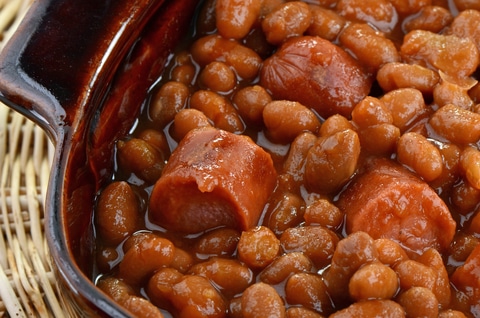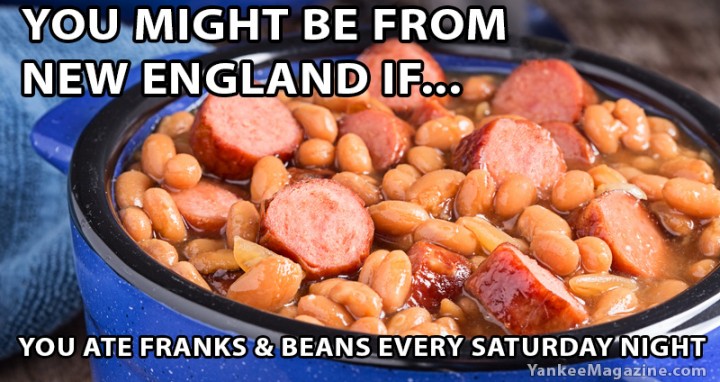Food
Franks and Beans On Saturday Night
Excerpt from “Beans and Harmony,” Yankee Magazine, February 1995. Being married to a Yankee meant we had franks and beans every Saturday night for years. Our eldest daughter hated beans, but her father insisted she eat every bean on her plate. I’d like to say that when she grew up she learned to like baked […]

Excerpt from “Beans and Harmony,” Yankee Magazine, February 1995. Being married to a Yankee meant we had franks and beans every Saturday night for years. Our eldest daughter hated beans, but her father insisted she eat every bean on her plate. I’d like to say that when she grew up she learned to like baked beans, but that would be a fairy story.
My husband longed for the flavor of true bean-hole beans. Those can sometimes be found at bean suppers, where deep pits are dug and great fires burn all day to create glowing hot coals. The cook then lowers the beans into the holes in vast black pots and covers them completely with ashes and earth, letting them bake slowly for two whole days. They are at last unearthed, lifted out, and a great feast is had by all. I, with my little saucepan and stirring spoon, had a hard time reproducing that flavor.
My most common mistake was to heat the beans too fast. I always turned the burner on high. That was heresy to the baking of beans. All too often the bean critic would shout from the living room, “Don’t ruin the beans! Cook them slowly!”
Eventually I learned to simulate a bean-hole supper by heating the brown, juicy morsels on the lowest setting for a half an hour and not interfering with them in any way. I kept myself busy with the rest of the supper — a very active exercise. I’d rush to the blender to whip up milk shakes, rush to butter the buns, check the boiling franks, make sure the beans were heating slowly, pour out the chips. It was a challenge to complete everything at once (the mark of a great chef).
I learned that the tension between fast and slow, the yin-yang of trying to achieve excellence with franks and beans, was the secret of not only a great supper, but of a marriage as well.
Being married to a Yankee meant we had franks and beans every Saturday night for years. Our eldest daughter hated beans, but her father insisted she eat every bean on her plate. I’d like to say that when she grew up she learned to like baked beans, but that would be a fairy story.
My husband longed for the flavor of true bean-hole beans. Those can sometimes be found at bean suppers, where deep pits are dug and great fires burn all day to create glowing hot coals. The cook then lowers the beans into the holes in vast black pots and covers them completely with ashes and earth, letting them bake slowly for two whole days. They are at last unearthed, lifted out, and a great feast is had by all. I, with my little saucepan and stirring spoon, had a hard time reproducing that flavor.
My most common mistake was to heat the beans too fast. I always turned the burner on high. That was heresy to the baking of beans. All too often the bean critic would shout from the living room, “Don’t ruin the beans! Cook them slowly!”
Eventually I learned to simulate a bean-hole supper by heating the brown, juicy morsels on the lowest setting for a half an hour and not interfering with them in any way. I kept myself busy with the rest of the supper — a very active exercise. I’d rush to the blender to whip up milk shakes, rush to butter the buns, check the boiling franks, make sure the beans were heating slowly, pour out the chips. It was a challenge to complete everything at once (the mark of a great chef).
I learned that the tension between fast and slow, the yin-yang of trying to achieve excellence with franks and beans, was the secret of not only a great supper, but of a marriage as well.
 Make a Batch: Classic Baked Franks and Beans Recipe
Make a Batch: Classic Baked Franks and Beans Recipe
 Being married to a Yankee meant we had franks and beans every Saturday night for years. Our eldest daughter hated beans, but her father insisted she eat every bean on her plate. I’d like to say that when she grew up she learned to like baked beans, but that would be a fairy story.
My husband longed for the flavor of true bean-hole beans. Those can sometimes be found at bean suppers, where deep pits are dug and great fires burn all day to create glowing hot coals. The cook then lowers the beans into the holes in vast black pots and covers them completely with ashes and earth, letting them bake slowly for two whole days. They are at last unearthed, lifted out, and a great feast is had by all. I, with my little saucepan and stirring spoon, had a hard time reproducing that flavor.
My most common mistake was to heat the beans too fast. I always turned the burner on high. That was heresy to the baking of beans. All too often the bean critic would shout from the living room, “Don’t ruin the beans! Cook them slowly!”
Eventually I learned to simulate a bean-hole supper by heating the brown, juicy morsels on the lowest setting for a half an hour and not interfering with them in any way. I kept myself busy with the rest of the supper — a very active exercise. I’d rush to the blender to whip up milk shakes, rush to butter the buns, check the boiling franks, make sure the beans were heating slowly, pour out the chips. It was a challenge to complete everything at once (the mark of a great chef).
I learned that the tension between fast and slow, the yin-yang of trying to achieve excellence with franks and beans, was the secret of not only a great supper, but of a marriage as well.
Being married to a Yankee meant we had franks and beans every Saturday night for years. Our eldest daughter hated beans, but her father insisted she eat every bean on her plate. I’d like to say that when she grew up she learned to like baked beans, but that would be a fairy story.
My husband longed for the flavor of true bean-hole beans. Those can sometimes be found at bean suppers, where deep pits are dug and great fires burn all day to create glowing hot coals. The cook then lowers the beans into the holes in vast black pots and covers them completely with ashes and earth, letting them bake slowly for two whole days. They are at last unearthed, lifted out, and a great feast is had by all. I, with my little saucepan and stirring spoon, had a hard time reproducing that flavor.
My most common mistake was to heat the beans too fast. I always turned the burner on high. That was heresy to the baking of beans. All too often the bean critic would shout from the living room, “Don’t ruin the beans! Cook them slowly!”
Eventually I learned to simulate a bean-hole supper by heating the brown, juicy morsels on the lowest setting for a half an hour and not interfering with them in any way. I kept myself busy with the rest of the supper — a very active exercise. I’d rush to the blender to whip up milk shakes, rush to butter the buns, check the boiling franks, make sure the beans were heating slowly, pour out the chips. It was a challenge to complete everything at once (the mark of a great chef).
I learned that the tension between fast and slow, the yin-yang of trying to achieve excellence with franks and beans, was the secret of not only a great supper, but of a marriage as well.
 Make a Batch: Classic Baked Franks and Beans Recipe
Make a Batch: Classic Baked Franks and Beans Recipe

